Multiyear Rainfall and Temperature Trends in the Volta River Basin and their Potential Impact on Hydropower Generation in Ghana
Abstract
:1. Introduction
2. Materials and Methods
2.1. Data Collection
2.2. Data Quality Control
2.3. Mann-Kendall Test
2.4. Sen’s Slope Estimator
2.5. Volta Basin Average Precipitation, Temperature, and Actual Evapotranspiration (AET)
3. Results and Discussions
3.1. Rainfall Variability in Ghana (1960–2010)
3.2. Temperature Variability in Ghana (1960—2011)
3.3. Discharge at Akosombo (1965–2014)
3.4. Potential Impact of Rainfall and Temperature Variations on Hydropower Generation
4. Conclusions
Acknowledgments
Author Contributions
Conflicts of Interest
References
- Feddema, J.J.; Oleson, K.W.; Bonan, G.B.; Mearns, L.O.; Buja, L.E.; Meehl, G.A.; Washington, W.M. The importance of land-cover change in simulating future climates. Science 2005, 310, 1674–1678. [Google Scholar] [CrossRef] [PubMed]
- Gordon, L.; Dunlop, M.; Foran, B. Land cover change and water vapour flows: Learning from Australia. Philos. Trans. R. Soc. Lond. Ser. B Biol. Sci. 2003, 358, 1973–1984. [Google Scholar] [CrossRef] [PubMed]
- Vorosmarty, C.J.; Sahagian, D. Anthropogenic disturbance of the terrestrial water cycle. BioScience 2000, 50, 753–765. [Google Scholar] [CrossRef]
- Milly, P.C.D.; Dunne, K.A. Trends in evaporation and surface cooling in the Mississippi River basin. Geophys. Res. Lett. 2001, 28, 1219–1222. [Google Scholar] [CrossRef]
- Destouni, G.; Jaramillo, F.; Prieto, C. Hydroclimatic shifts driven by human water use for food and energy production. Nat. Clim. Chang. 2013, 3, 213–217. [Google Scholar] [CrossRef]
- Degu, A.M.; Hossain, F.; Niyogi, D.; Pielke, R.; Shepherd, J.M.; Voisin, N.; Chronis, T. The influence of large dams on surrounding climate and precipitation patterns. Geophys. Res. Lett. 2011, 38. [Google Scholar] [CrossRef]
- Milly, P.C.D. Climate, soil water storage, and the average annual water balance. Water Resour. Res. 1994, 30, 2143–2156. [Google Scholar] [CrossRef]
- Reynolds, J.F.; Kemp, P.R.; Tenhunen, J.D. Effects of long-term rainfall variability on evapotranspiration and soil water distribution in the Chihuahuan Desert: A modeling analysis. Plant Ecol. 2000, 150, 145–159. [Google Scholar] [CrossRef]
- Akpoti, K.; Antwi, E.O.; Kabo-Bah, A.T. Impacts of rainfall variability, land use and land cover change on stream flow of the black Volta Basin, West Africa. Hydrology 2016, 3, 26. [Google Scholar] [CrossRef]
- IPCC. Climate Change 2014: Mitigation of Climate Change; Cambridge University Press: Cambridge, UK, 2015. [Google Scholar]
- Madani, K. Hydropower licensing and climate change: Insights from cooperative game theory. Adv. Water Resour. 2011. [Google Scholar] [CrossRef]
- Jaramillo, F.; Destouni, G. Local flow regulation and irrigation raise global human water consumption and footprint. Science 2015, 350, 1248–1251. [Google Scholar] [CrossRef] [PubMed]
- The Global Runoff Data Centre (GRDC). Monthly Runoff Information of Station Number 1531700 of the Volta River; GRDC: Koblenz, Germany, 2016. [Google Scholar]
- Paulhus, J.L.; Kohler, M.A. Interpolation of missing precipitation records. Mon. Weather Rev. 1952. [Google Scholar] [CrossRef]
- Eischeid, J.K.; Bruce Baker, C.; Karl, T.R.; Diaz, H.F. The quality control of long-term climatological data using objective data analysis. J. Appl. Meteorol. 1995, 34, 2787–2795. [Google Scholar] [CrossRef]
- Eischeid, J.K.; Pasteris, P.A.; Diaz, H.F.; PLantico, M.S.; Lott, N.J. Creating a serially complete, national daily time series of temperature and precipitation for the Western United States. J. Appl. Meteorol. 2000, 39, 1580–1591. [Google Scholar] [CrossRef]
- Romero, R.; Guijarro, J.A.; Ramis, C.; Alonso, S. A 30-year (1964–1993) daily rainfall data base for the Spanish mediterranean regions: First exploratory. Int. J. Climatol. 1998, 560, 541–560. [Google Scholar] [CrossRef]
- Gocic, M.; Trajkovic, S. Analysis of changes in meteorological variables using Mann-Kendall and Sen’s slope estimator statistical tests in Serbia. Glob. Planet. Chang. 2013, 100, 172–182. [Google Scholar] [CrossRef]
- Tabari, H.; Marofi, S.; Ahmadi, M. Long-term variations of water quality parameters in the Maroon River, Iran. Environ. Monit. Assess. 2011, 177, 273–287. [Google Scholar] [CrossRef] [PubMed]
- Salmi, T.; Määttä, A.; Anttila, P.; Ruoho-Airola, T.; Amnell, T. Detecting Trends of Annual Values of Atmospheric Pollutants by the Mann-Kendall Test and Sen’s Slope Estimates—The Excel Template Application MAKESENS; Finnish Meteorological Institute: Helsinki, Finland, 2002. [Google Scholar]
- Hirsch, R.M.; Slack, J.R.; Smith, R.A. Techniques of trend analysis for monthly water quality data. Water Resour. Res. 1982, 18, 107–121. [Google Scholar] [CrossRef]
- Xu, Z.X.; Li, J.Y.; Liu, C.M. Long-term trend analysis for major climate variables in the Yellow River basin. Hydrol. Process. 2007. [Google Scholar] [CrossRef]
- Sen, P.K. Estimates of the regression coefficient based on Kendall’s tau. J. Am. Stat. Assoc. 1968, 63, 1379–1389. [Google Scholar] [CrossRef]
- Nasher, N.M.R.; Uddin, M.N. Maximum and minimum temperature trends variation over northern and southern part of Bangladesh. J. Environ. Sci. Nat. Resour. 2013, 6, 83–88. [Google Scholar] [CrossRef]
- Thiessen, A.H. Precipitation averages for large areas. Mon. Weather Rev. 1911, 39, 1082–1089. [Google Scholar] [CrossRef]
- Jaramillo, F.; Prieto, C.; Lyon, S.W.; Destouni, G. Multimethod assessment of evapotranspiration shifts due to non-irrigated agricultural development in Sweden. J. Hydrol. 2013, 484, 55–62. [Google Scholar] [CrossRef]
- Adu-Gyamerah, E. Alternative Power Needed. Available online: http://www.graphic.com.gh/features/opinion/26002-alternative-power-needed.html (accessed on 18 January 2016).
- DailyGraphic. The Power Crisis in Ghana: Analysis of the Causal Factors from the Perspectives of Public. Available online: http://www.graphic.com.gh/features/opinion/39140-the-power-crisis-in-ghana-analysis-of-the-causal-factors-from-the-perspectives-of-public-officials.html (accessed on 18 January 2015).
- Trabucco, A.; Zomer, R.J. Global Aridity Index (Global-Aridity) and Global Potential Evapo-Transpiration (Global-PET) Geospatial Database; CGIAR Consortium for Spatial Information: Washington, DC, USA, 2006. [Google Scholar]
- Markoff, M.S.; Cullen, A.C. Impact of climate change on Pacific Northwest hydropower. Clim. Chang. 2008, 87, 451–469. [Google Scholar] [CrossRef]
- Schaefli, B.; Hingray, B.; Musy, A. Climate change and hydropower production in the Swiss Alps: Quantification of potential impacts and related modelling uncertainties. Hydrol. Earth Syst. Sci. Discuss. 2007, 11, 1191–1205. [Google Scholar] [CrossRef]
- United Nations Framework Convention on Climate Change Secretariat (UNFCCCS). Climate Change: Impacts, Vulnerabilities, and Adaptation in Developing Countries; United Nations Framework Convention on Climate Change Secretariat: Bonn, Germany, 2007. [Google Scholar]
- Ministry of Environment. Ghana Goes for Green Growth; Ministry of Environment, Science and Technology: Accra, Ghana, 2010.
- Cameron, C. Climate Change Financing and Aid Effectiveness: Ghana Case Study; Agulhas Applied Knowledge. Available online: www.oecd.org/dac/environment-development/48458430.pdf (accessed on 24 September 2016).
- World Bank. Economics of Adaptation to Climate Change. Ghana Country Study; World Bank: Washington, DC, USA, 2010. [Google Scholar]
- Ghana News. Akosombo Dam Water Level Expected to Drop to Record Low; Ghana News: Accra, Ghana, 2014. Available online: http://www.myjoyonline.com/business/2014/april-23rd/akosombo-dam-water-level-expected-to-drop-to-record-low.php (accessed on 30 March 2016).
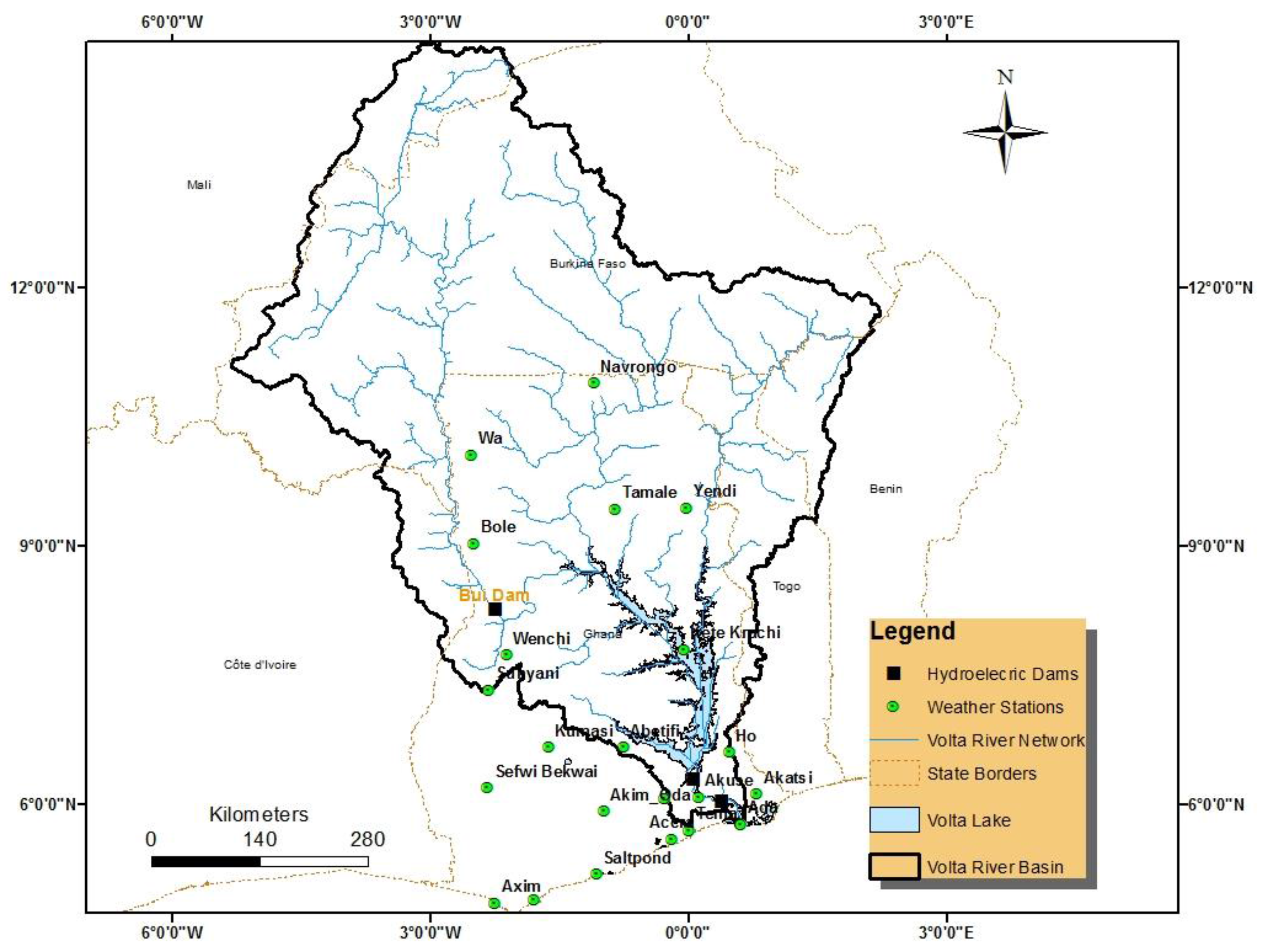
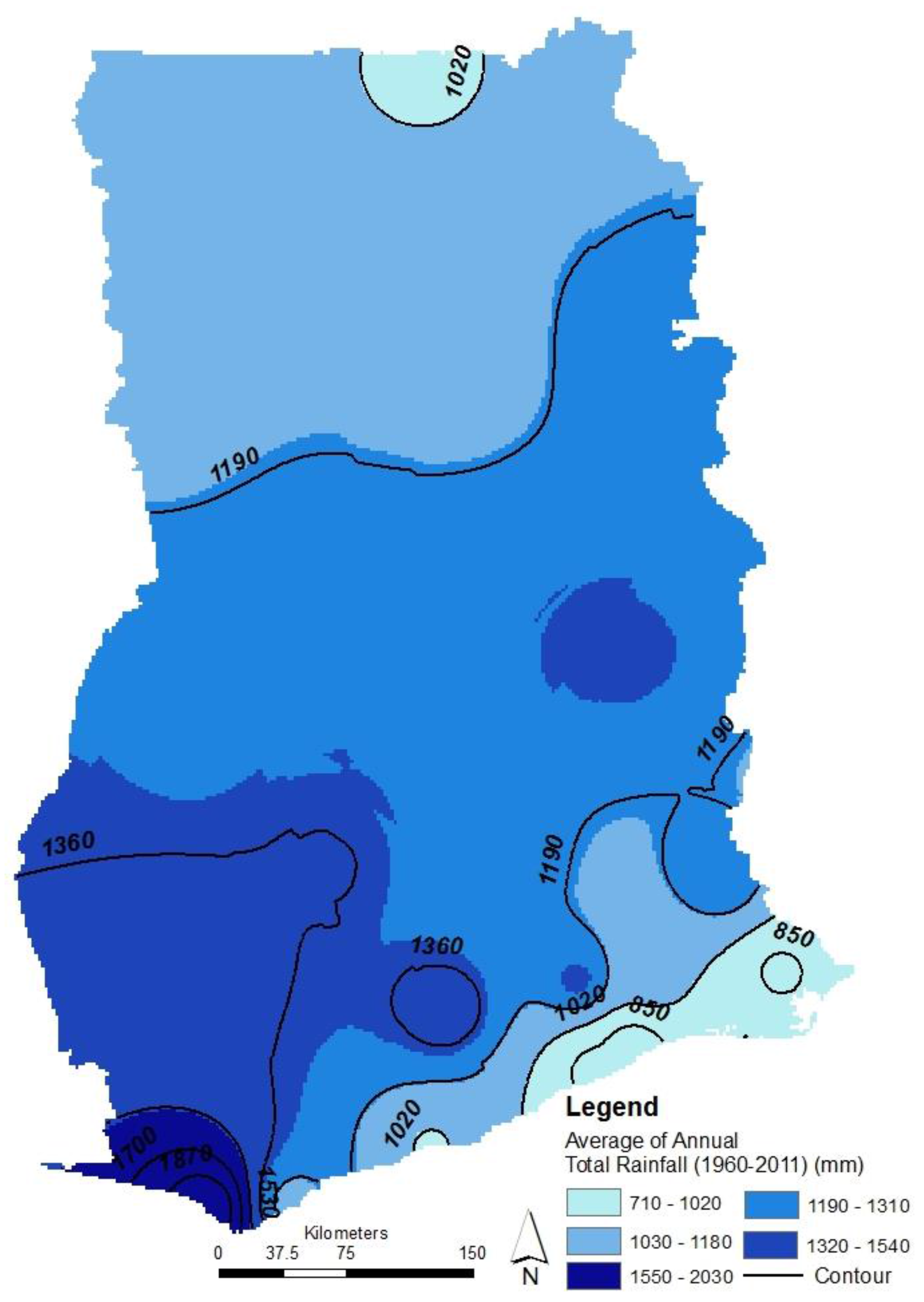
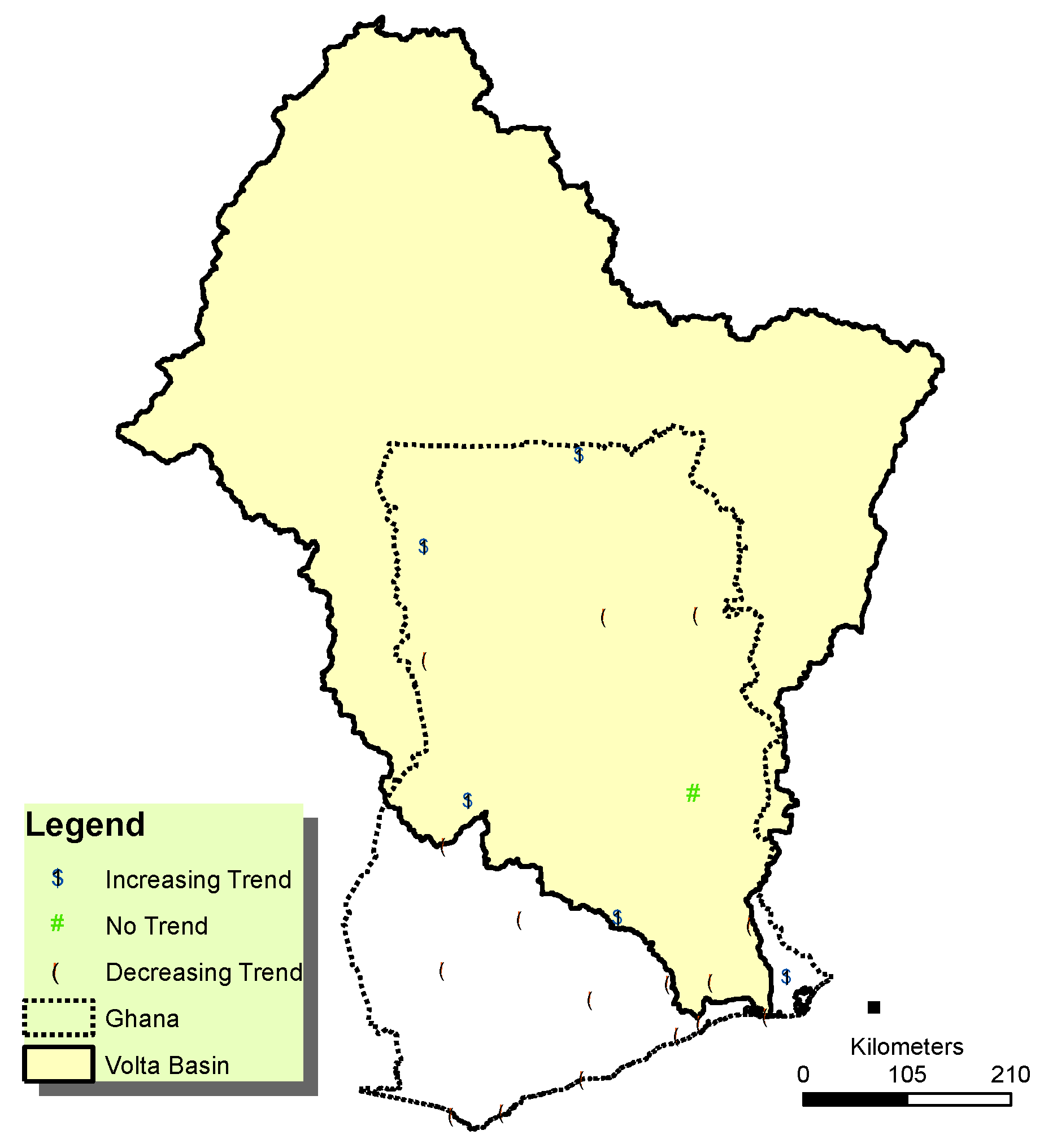
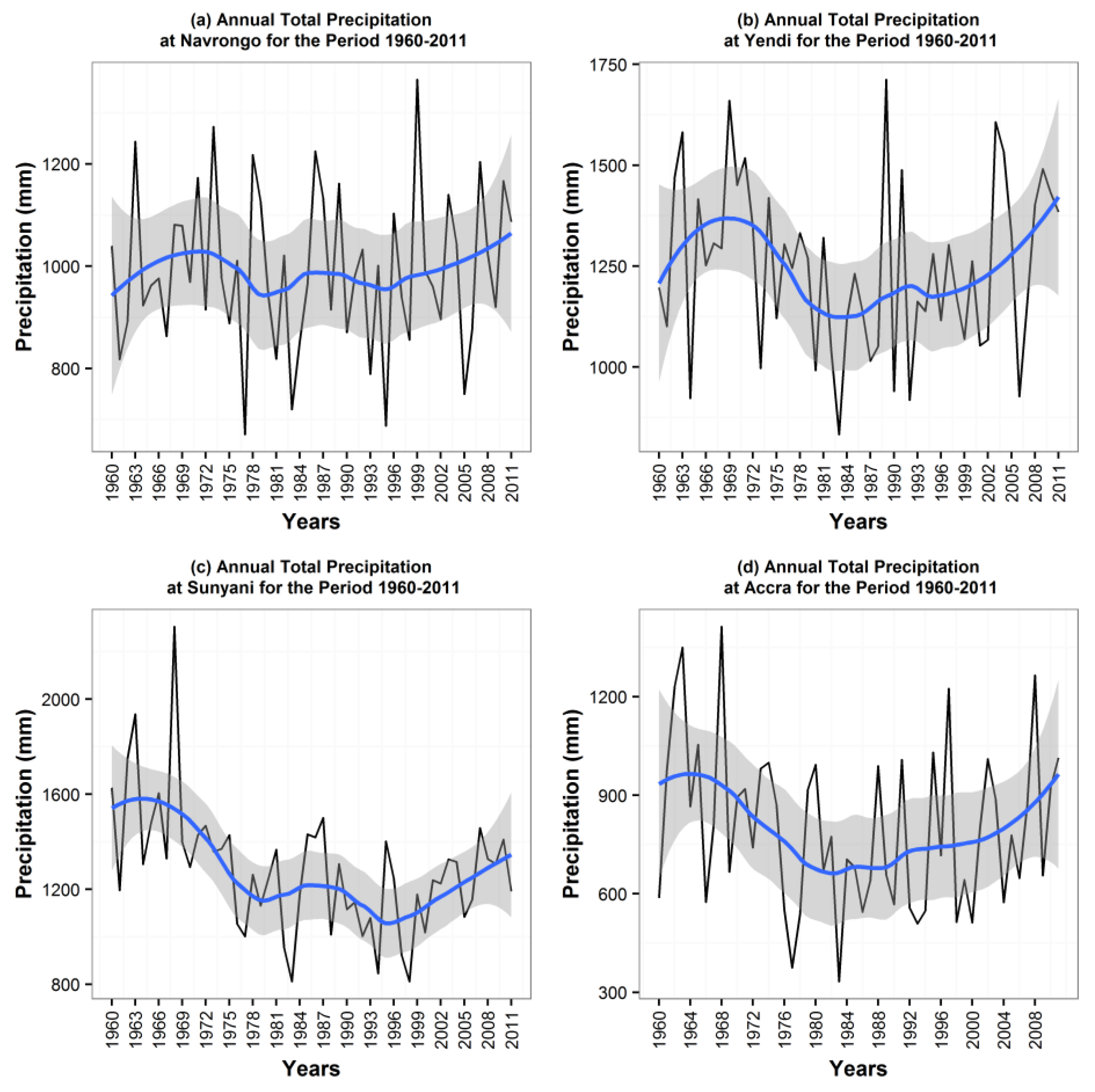
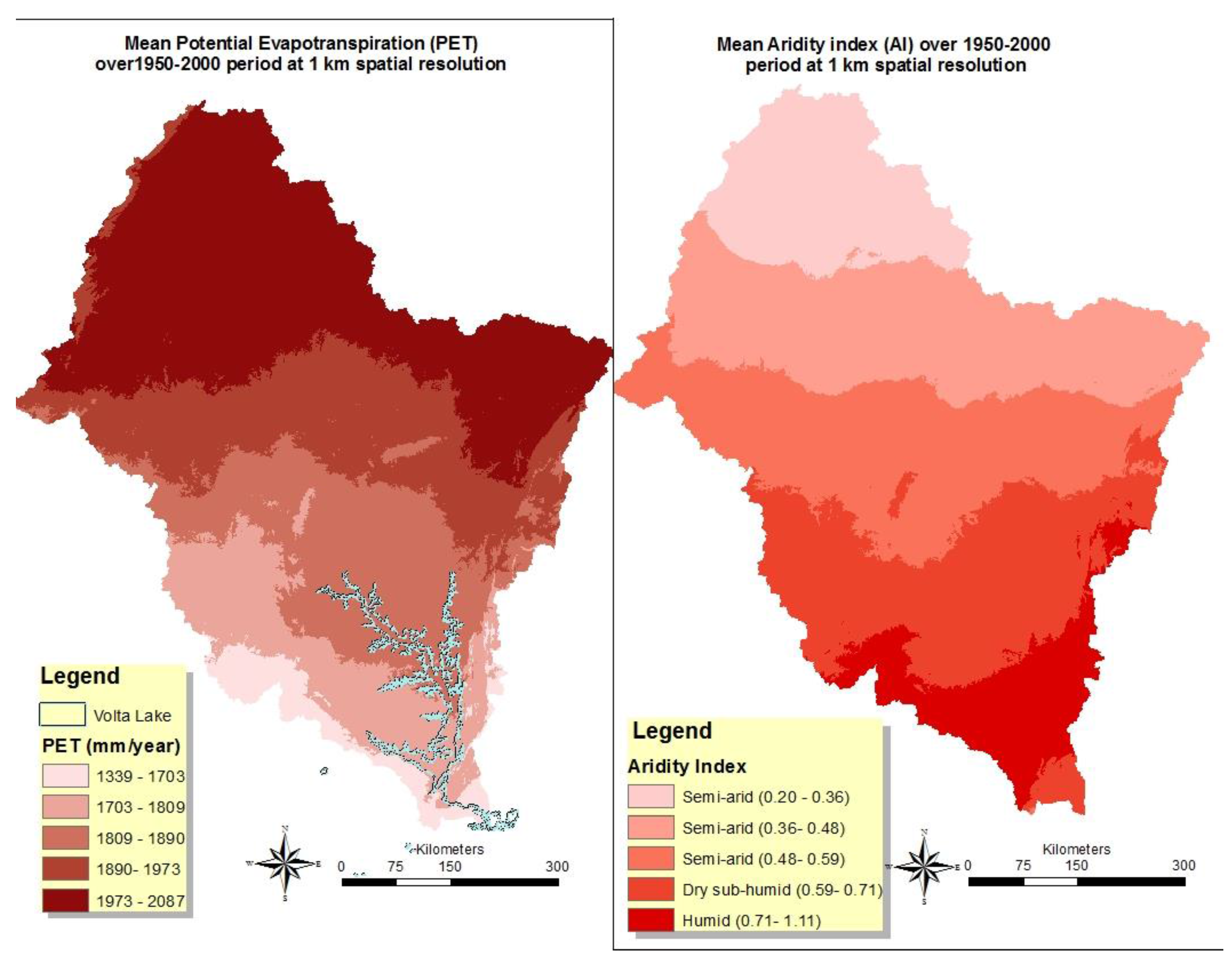
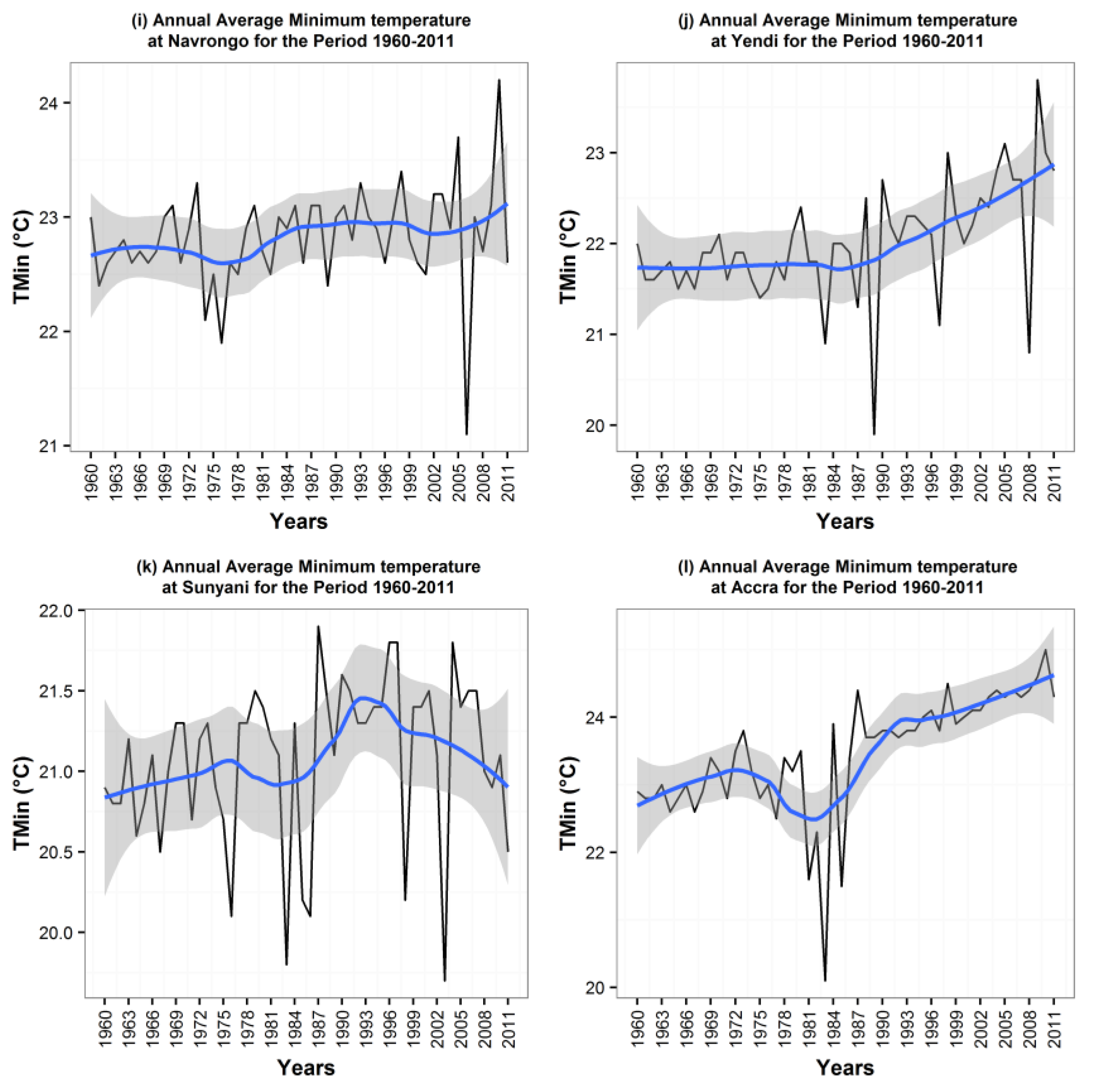
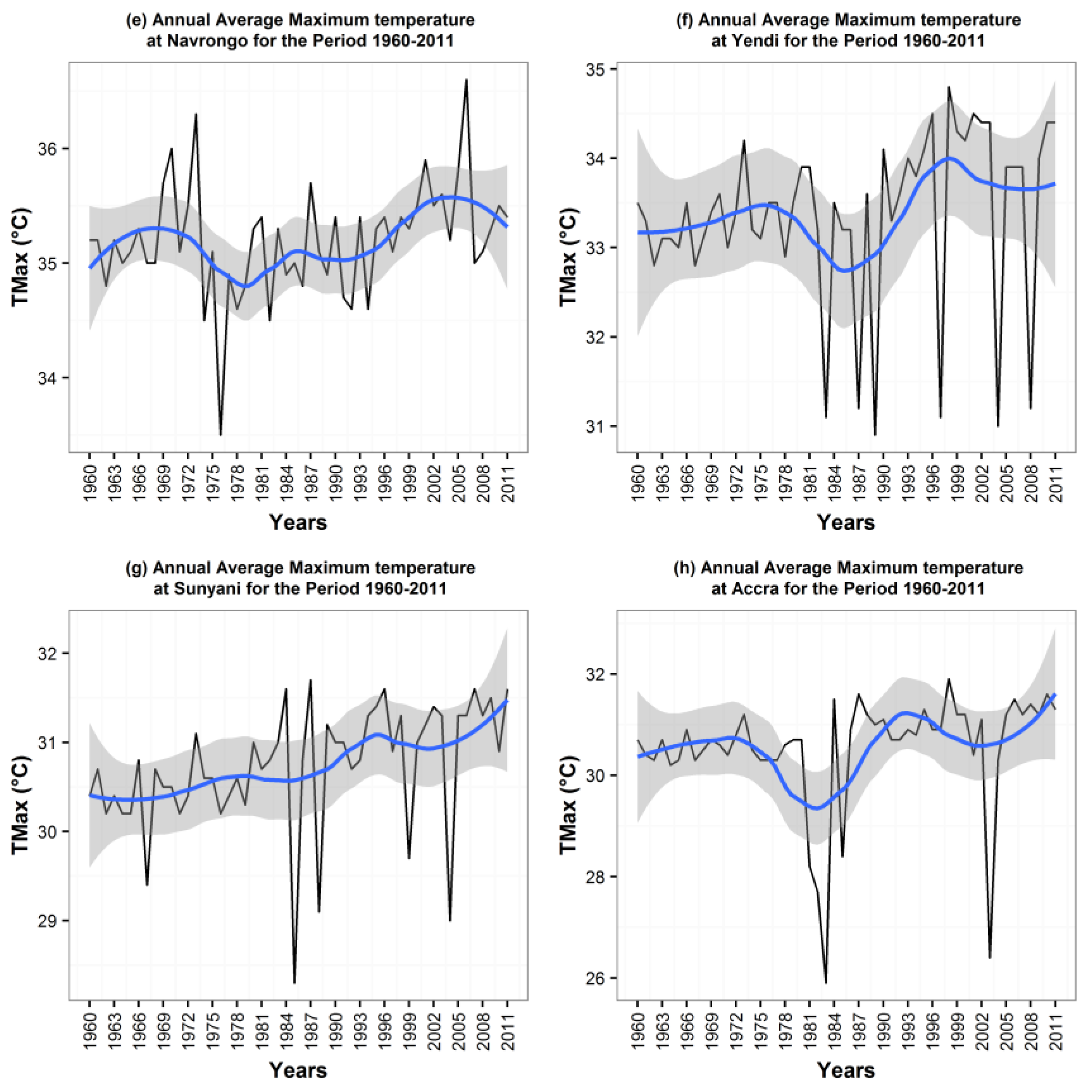
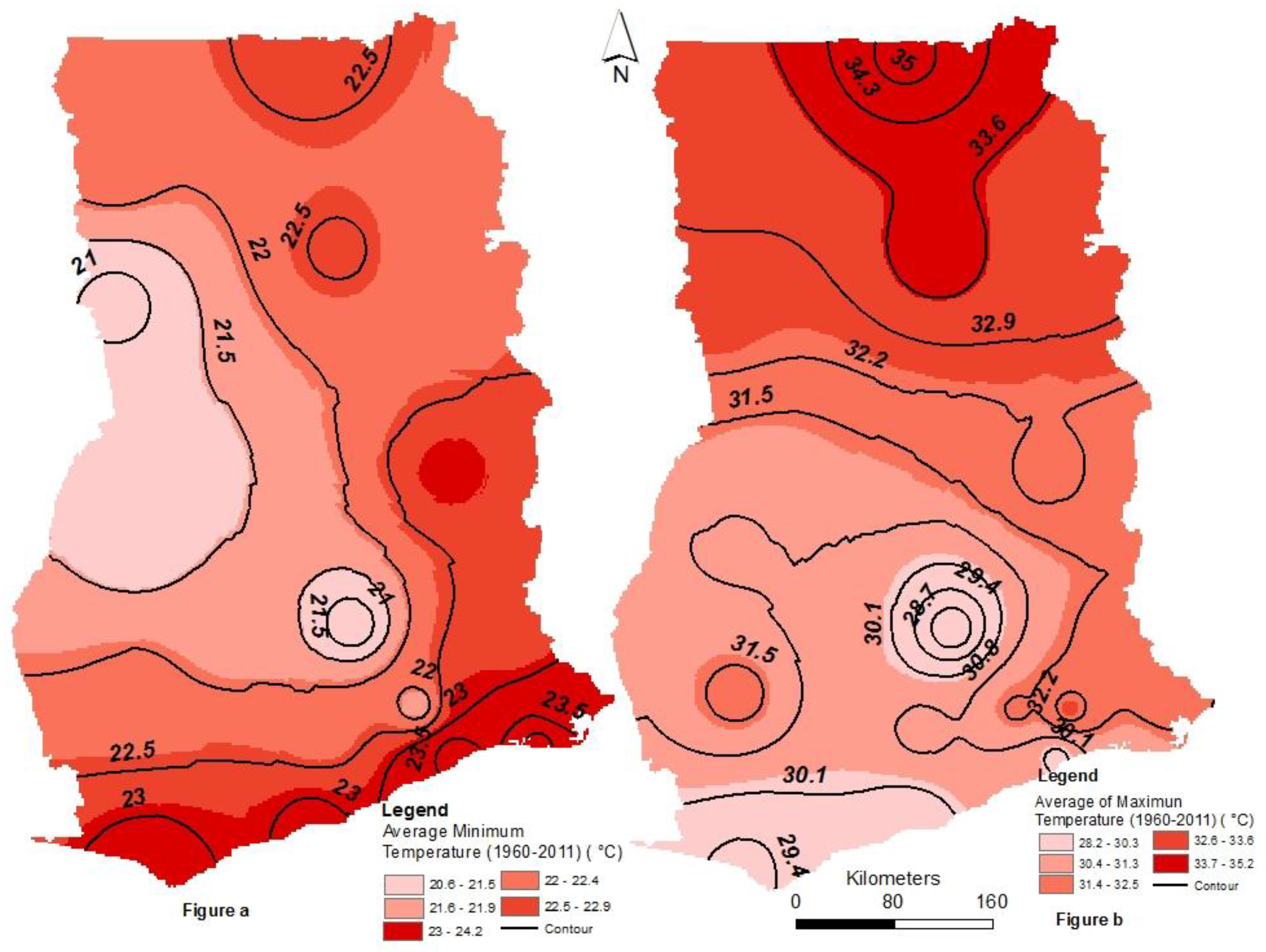
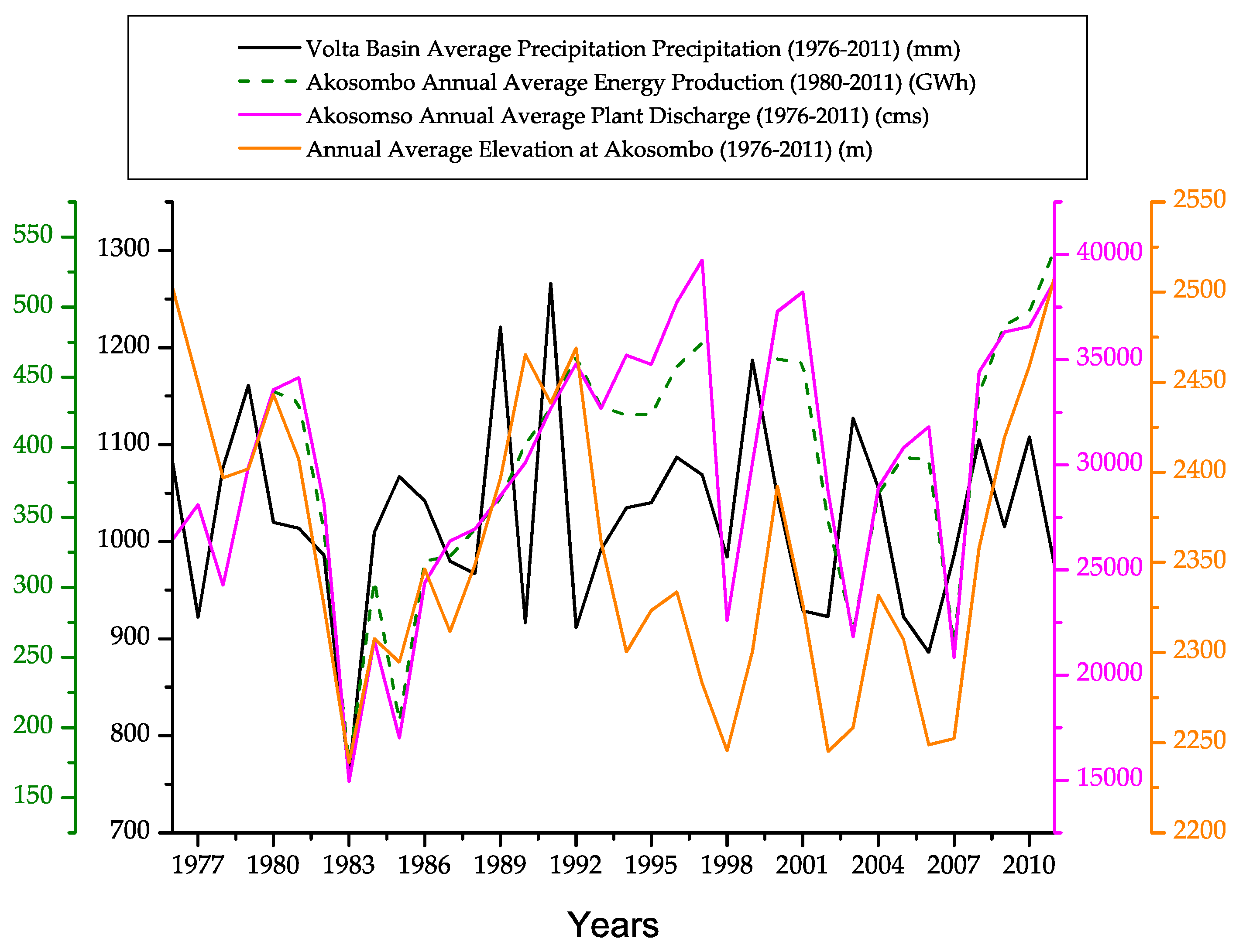
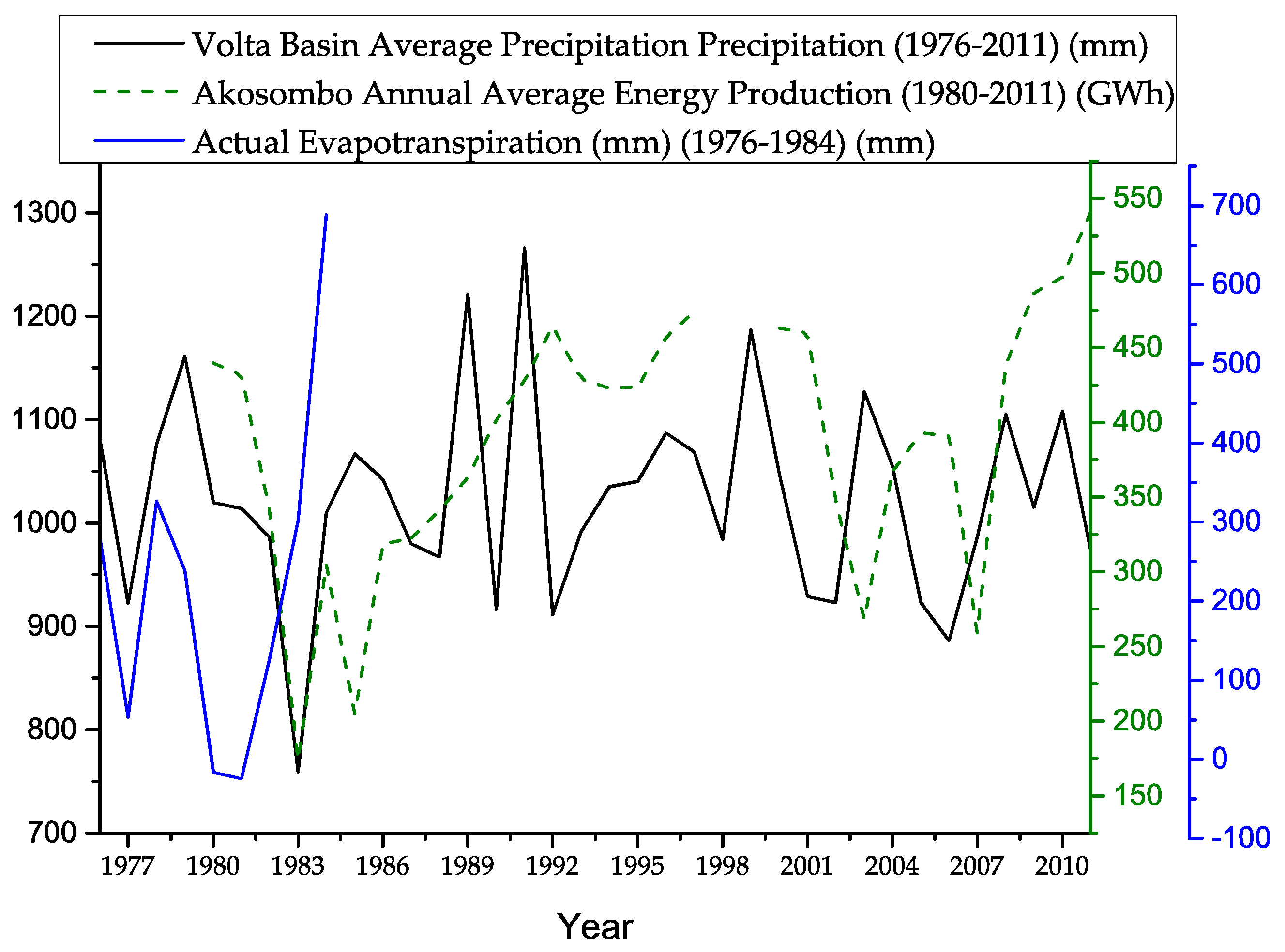
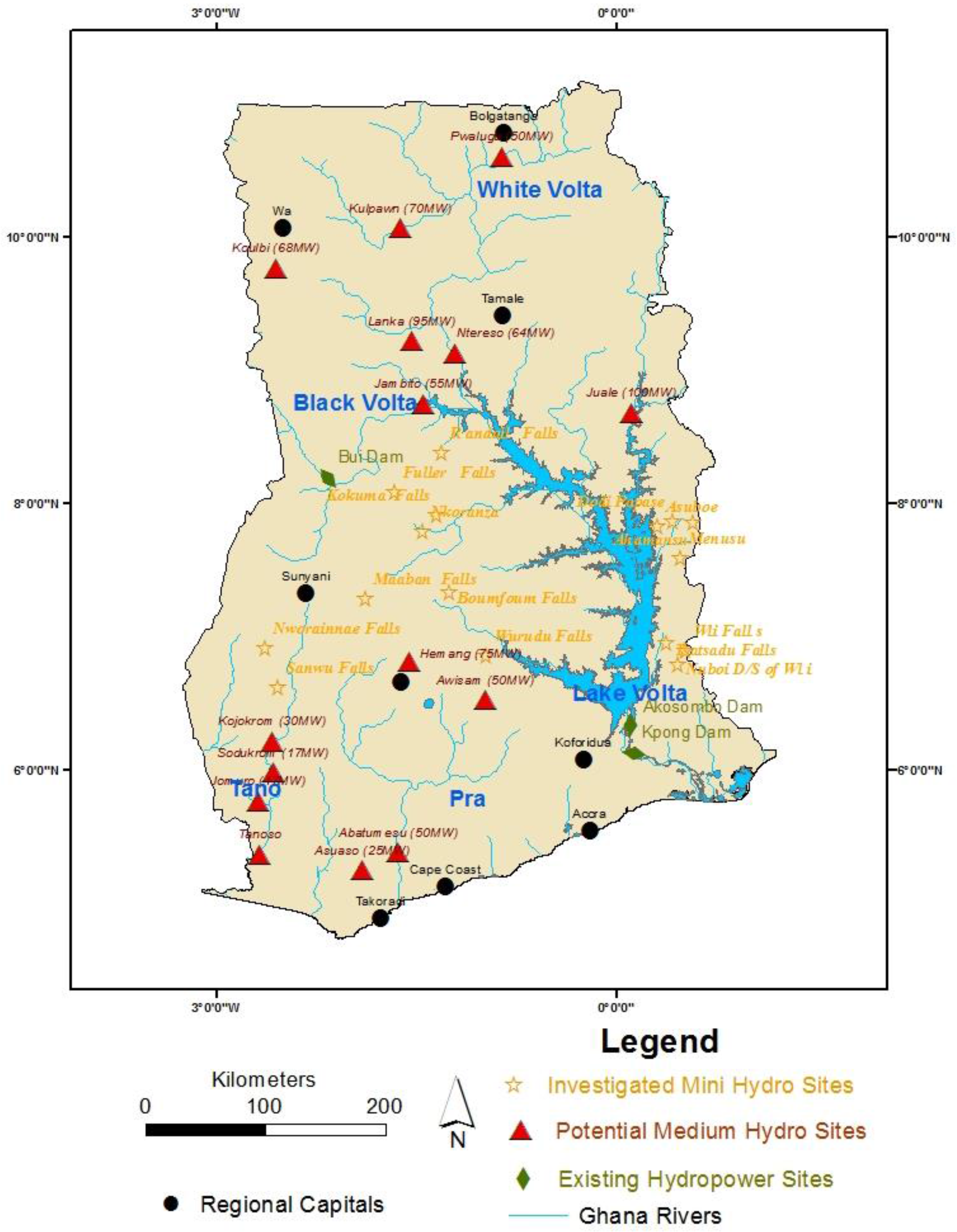
| Stations | Percentage of Missing Data (%) | ||
|---|---|---|---|
| Annual Total Precipitation | Annual Minimum Temperature | Annual Maximum Temperature | |
| Abetifi | 1.92 | 40.38 | 40.38 |
| Accra | 1.92 | 5.80 | 5.80 |
| Ada | 0.00 | 0.00 | 0.00 |
| Akatsi | 40.38 | 34.62 | 34.62 |
| Akim Oda | 30.00 | 26.90 | 26.90 |
| Akuse | 36.5 | 15.38 | 13.50 |
| Axim | 0.00 | 9.62 | 9.62 |
| Bole | 3.80 | 17.30 | 17.30 |
| Ho | 0.00 | 7.70 | 9.62 |
| Kete Krachi | 0.00 | 15.40 | 15.40 |
| Koforidua | 9.60 | 7.70 | 23.10 |
| Kumasi | 0.00 | 0.00 | 0.00 |
| Navrongo | 0.00 | 34.62 | 32.70 |
| Saltpond | 0.00 | 11.50 | 11.50 |
| Sefwi Bekwai | 7.70 | 7.70 | 7.70 |
| Sunyani | 30 | 42.30 | 44.23 |
| Takoradi | 30 | 7.70 | 40.38 |
| Tamale | 0.00 | 0.00 | 3.80 |
| Tema | 9.60 | 3.80 | 3.80 |
| Wa | 0.00 | 0.00 | 0.00 |
| Wenchi | 0.00 | 13.50 | 11.50 |
| Yendi | 0.00 | 13.50 | 13.50 |
| Stations | Meteorological Parameters | Stations | Meteorological Parameters | ||||||
|---|---|---|---|---|---|---|---|---|---|
| Test | Rainfall | Tmin | Tmax | Test | Rainfall | Tmin | Tmax | ||
| Wa | Zs | 0.189 | 5.650 *** | 5.729 *** | Akatsi | Zs | 1.302 | 5.871 *** | 4.585 *** |
| Qmed | 0.254 | 0.031 | 0.028 | Qmed | 2.316 | 0.025 | 0.021 | ||
| Navrongo | Zs | 0.402 | 2.675 ** | 2.044 * | Sefwi Bekwai | Zs | −1.673 + | 3.512 *** | 5.184 *** |
| Qmed | 0.600 | 0.010 | 0.008 | Qmed | −2.719 | 0.021 | 0.041 | ||
| Bole | Zs | −0.663 | 4.151 *** | 4.332 *** | Kumasi | Zs | −0.813 | 5.548 *** | 6.179 *** |
| Qmed | −1.573 | 0.019 | 0.022 | Qmed | −2.067 | 0.025 | 0.034 | ||
| Tamale | Zs | −0.213 | 4.798 *** | 4.814 *** | Akim Oda | Zs | −1.594 | 5.816 *** | 5.224 *** |
| Qmed | −0.429 | 0.020 | 0.024 | Qmed | −4.111 | 0.019 | 0.025 | ||
| Yendi | Zs | −0.402 | 4.530 *** | 3.606 *** | Koforidua | Zs | −1.634 | 5.816 *** | 5.563 *** |
| Qmed | −0.894 | 0.022 | 0.022 | Qmed | −3.901 | 0.029 | 0.028 | ||
| Kete Krachi | Zs | 0.000 | 4.435 *** | 3.930 *** | Axim | Zs | −1.728+ | 2.872 ** | 3.496 *** |
| Qmed | 0.000 | 0.024 | 0.029 | Qmed | −7.744 | 0.014 | 0.017 | ||
| Ho | Zs | −1.610 | 6.432 *** | 5.216 *** | Ada | Zs | −0.876 | 4.774 *** | 2.257 * |
| Qmed | −2.448 | 0.026 | 0.022 | Qmed | −2.098 | 0.021 | 0.011 | ||
| Wenchi | Zs | 0.032 | 5.619 *** | 4.995 *** | Takoradi | Zs | −1.018 | 5.390 *** | 3.314 *** |
| Qmed | 0.071 | 0.024 | 0.024 | Qmed | −2.048 | 0.026 | 0.015 | ||
| Sunyani | Zs | −2.723 ** | 2.304 * | 4.695 *** | Accra | Zs | −0.797 | 6.558 *** | 3.969 *** |
| Qmed | −6.167 | 0.009 | 0.023 | Qmed | −1.693 | 0.036 | 0.019 | ||
| Akuse | Zs | −2.943 | 4.411 *** | 5.809 *** | Tema | Zs | −0.734 | 7.182 *** | 5.842 *** |
| Qmed | −5.967 ** | 0.020 | 0.028 | Qmed | −1.650 | 0.041 | 0.022 | ||
| Abetifi | Zs | 0.103 | 5.406 *** | 5.547 *** | Saltpond | Zs | −1.594 | 5.399 *** | 4.057 *** |
| Qmed | 0.243 | 0.020 *** | 0.018 | Qmed | −3.877 | 0.024 | 0.031 | ||
| Parameters | Test Zs | Significance | Qmed |
|---|---|---|---|
| Water level | −2.11 | * | −7.974 (m/year) |
| Discharge | 4.93 | *** | 15,441.1(m3/year) |
© 2016 by the authors; licensee MDPI, Basel, Switzerland. This article is an open access article distributed under the terms and conditions of the Creative Commons Attribution (CC-BY) license (http://creativecommons.org/licenses/by/4.0/).
Share and Cite
Kabo-Bah, A.T.; Diji, C.J.; Nokoe, K.; Mulugetta, Y.; Obeng-Ofori, D.; Akpoti, K. Multiyear Rainfall and Temperature Trends in the Volta River Basin and their Potential Impact on Hydropower Generation in Ghana. Climate 2016, 4, 49. https://doi.org/10.3390/cli4040049
Kabo-Bah AT, Diji CJ, Nokoe K, Mulugetta Y, Obeng-Ofori D, Akpoti K. Multiyear Rainfall and Temperature Trends in the Volta River Basin and their Potential Impact on Hydropower Generation in Ghana. Climate. 2016; 4(4):49. https://doi.org/10.3390/cli4040049
Chicago/Turabian StyleKabo-Bah, Amos T., Chuks. J. Diji, Kaku Nokoe, Yacob Mulugetta, Daniel Obeng-Ofori, and Komlavi Akpoti. 2016. "Multiyear Rainfall and Temperature Trends in the Volta River Basin and their Potential Impact on Hydropower Generation in Ghana" Climate 4, no. 4: 49. https://doi.org/10.3390/cli4040049






